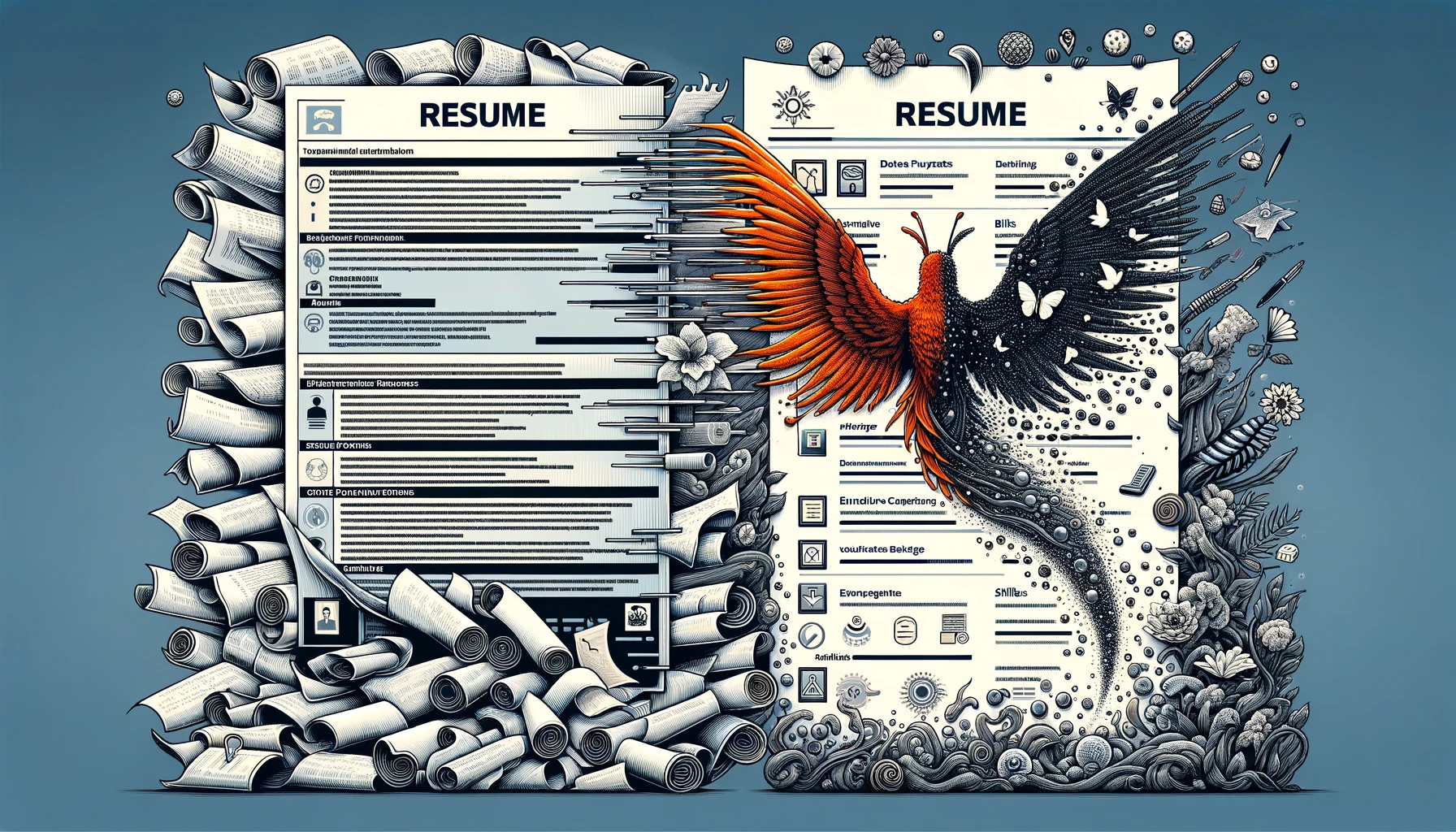In a sea of cookie-cutter resumes flooding hiring managers’ inboxes, there lies a powerful tool often overlooked yet capable of setting you apart: storytelling.
Gone are the days when resumes were mere lists of qualifications and experiences. Today, crafting a compelling narrative has become the secret ingredient to capturing recruiters’ attention and landing that dream job.
Imagine your resume not as a dull document but as a vibrant canvas where each experience serves as a brushstroke, painting a vivid picture of who you are beyond just titles and achievements.
This article delves into the art of weaving narratives within the confines of bullet points, showcasing how storytelling can transform your resume from mundane to magnetic.
From framing your career journey as an engaging story arc to strategically highlighting key moments like plot twists, this guide will equip you with the tools needed to craft not just any resume but one that leaves recruiters eager to learn more about the person behind it.
Join us on this exploration into the world of storytelling in resumes – where words transcend paper, anecdotes spark connections, and your professional story unfolds in ways that resonate deeply with those holding the keys to your next career chapter.
Let’s unravel the mysteries behind creating a resume that speaks volumes even before uttering a word in person. Welcome to Crafting Your Story: The Art of Writing A Compelling Resume.
Understanding Your Target Audience:
Crafting a resume is not just about listing your achievements; it’s about tailoring your story to resonate with the specific needs of your target audience. Before diving into the writing process, take the time to research the company and job requirements thoroughly.
Identify key skills and experiences that are most relevant to the position you’re applying for. By understanding what recruiters are looking for, you can strategically highlight your strengths in a way that captures their attention.
Once you have a clear picture of your target audience, aligning your story with job requirements becomes crucial. Consider how each experience or skill you include in your resume contributes to meeting the expectations outlined in the job description.
Instead of simply stating responsibilities, focus on showcasing tangible accomplishments that demonstrate your ability to excel in the role. By weaving these elements seamlessly into your narrative, you create a compelling case for why you are the perfect fit for the position.
Remember, alignment is not just about mirroring keywords but showcasing how your unique story fulfills the employer’s needs and adds value to their team.
Crafting Your Narrative
In the world of resume writing, crafting your narrative is more than just detailing past experiences; it’s about creating a compelling story that captivates recruiters from the start. One powerful technique to achieve this is by structuring your resume like a well-crafted tale.
Begin with an engaging introduction that sets the scene for what follows, highlighting your unique selling points and building intrigue about your career journey. As you delve into each section, allow the narrative to unfold naturally, connecting dots between experiences to showcase growth and skill development.
One key element in weaving this narrative is the strategic use of action verbs and engaging language. Instead of simply listing job duties, ignite interest by using dynamic verbs that convey impact and achievement. For instance, swap out mundane phrases like responsible for with action-packed alternatives such as drove, orchestrated, or pioneered.
By infusing such energetic language throughout your resume, you not only elevate the storytelling quality but also leave a lasting impression on hiring managers who are inundated with standard applications daily.
Remember, every word has the potential to shape how your story unfolds on paper—make each one count in portraying yourself as a protagonist worth considering for their team’s success.
Showcasing Achievements Effectively
When it comes to crafting a compelling resume, one of the most impactful strategies is showcasing achievements through storytelling. Instead of simply listing job responsibilities and tasks, incorporating narratives that highlight specific accomplishments can truly set your resume apart.
By framing your achievements within a storytelling context, you provide recruiters with a more engaging and memorable glimpse into your skills and capabilities.
Moreover, quantifying results adds a powerful element to your storytelling approach. Numbers have a way of instantly conveying the impact of your achievements – whether it’s increasing sales by 20%, leading a project that resulted in cost savings of $50,000, or boosting website traffic by 30%.
Quantifying results not only makes your accomplishments more tangible but also demonstrates your ability to deliver concrete outcomes. When weaving these quantifiable metrics into the narrative structure of your resume, you paint a vivid picture of success that resonates with potential employers and showcases the value you bring to the table.
Tailoring Your Resume for Specific Roles
Crafting a resume that resonates with specific job roles involves more than just rearranging bullet points; it requires the art of customization. When customizing your stories for different job applications, focus on aligning your experiences with the specific requirements and responsibilities outlined in each job description.
By making deliberate connections between your past accomplishments and the skills needed for the role, you can show recruiters how your unique background fits seamlessly into their team puzzle.
Consider each job application as an opportunity to tell a tailored story that showcases your qualifications in a compelling light. Highlight experiences that directly relate to the key responsibilities of the position, emphasizing how your skills and achievements match what the employer is seeking.
By weaving together a narrative that speaks directly to the needs of each role, you not only demonstrate your understanding of the company’s goals but also present yourself as a candidate who is ready to step into that particular position with confidence and impact.
Remember, it’s not about changing who you are – it’s about presenting yourself in a way that highlights why you are uniquely suited for each opportunity.
Visual Appeal & Formatting – Enhancing readability through design choices
In the realm of resume crafting, visual appeal and formatting play a pivotal role in capturing the attention of recruiters amidst a sea of applications. Beyond just listing accomplishments and experiences, how you present this information visually can make or break your chances at securing that coveted interview.
The strategic use of whitespace, headers, bullet points, and font styles can help guide the reader’s eyes smoothly through your resume.
Furthermore, consider using visual elements to complement the narrative you’re weaving throughout your document. For instance, incorporating subtle icons to represent key skills or achievements can not only break up dense text but also provide a visual anchor for important information.
Remember, while substance is crucial, style should not be overlooked—it is often these design nuances that subconsciously leave a lasting impression on those reviewing your application. So embrace creativity within the boundaries of professionalism to craft a visually appealing resume that harmoniously blends form and function.
Conclusion
As we reach the end of this journey into the art of crafting a compelling resume through storytelling, it’s crucial to recap on the powerful impact narrative elements can have in shaping your professional brand.
By infusing your resume with stories that showcase not just what you’ve done but who you are as a candidate, you transform a mere list of qualifications into a captivating narrative that recruiters and employers won’t soon forget.
Remember, your story is what sets you apart from other applicants; it’s the unique thread that ties together your experiences and aspirations.
Now armed with fresh insights and practical tips on how to harness the power of storytelling in resumes, I urge you to take action. Embrace the challenge of reframing your achievements and skills within a narrative framework—see yourself not just as someone seeking a job but as a storyteller weaving together past accomplishments and future aspirations.
Trust in the value of showcasing your authentic self through well-crafted narratives, for it is this authenticity that will resonate most strongly with those reviewing your application. So go forth with confidence, apply these storytelling techniques to your resume, and watch as doors begin to open before you—a testament to the transformative power of telling your own story.





